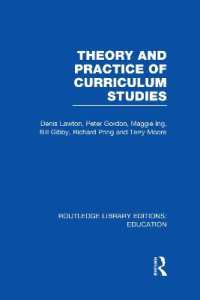- ホーム
- > 洋書
- > 英文書
- > Science / Mathematics
基本説明
Provides the latest theory and techniques for using simulated evolution to achieve machine intelligence. As a leading advocate for evolutionary computation, the author has successfully challenged the traditional notion of artificial intelligence, which essentially programs human knowledge fact by fact, but does not have the capacity to learn or adapt as evolutionary computation does.
Full Description
This Third Edition provides the latest tools and techniques that enable computers to learn
The Third Edition of this internationally acclaimed publication provides the latest theory and techniques for using simulated evolution to achieve machine intelligence. As a leading advocate for evolutionary computation, the author has successfully challenged the traditional notion of artificial intelligence, which essentially programs human knowledge fact by fact, but does not have the capacity to learn or adapt as evolutionary computation does.
Readers gain an understanding of the history of evolutionary computation, which provides a foundation for the author's thorough presentation of the latest theories shaping current research. Balancing theory with practice, the author provides readers with the skills they need to apply evolutionary algorithms that can solve many of today's intransigent problems by adapting to new challenges and learning from experience. Several examples are provided that demonstrate how these evolutionary algorithms learn to solve problems. In particular, the author provides a detailed example of how an algorithm is used to evolve strategies for playing chess and checkers.
As readers progress through the publication, they gain an increasing appreciation and understanding of the relationship between learning and intelligence. Readers familiar with the previous editions will discover much new and revised material that brings the publication thoroughly up to date with the latest research, including the latest theories and empirical properties of evolutionary computation.
The Third Edition also features new knowledge-building aids. Readers will find a host of new and revised examples. New questions at the end of each chapter enable readers to test their knowledge. Intriguing assignments that prepare readers to manage challenges in industry and research have been added to the end of each chapter as well.
This is a must-have reference for professionals in computer and electrical engineering; it provides them with the very latest techniques and applications in machine intelligence. With its question sets and assignments, the publication is also recommended as a graduate-level textbook.
Contents
Preface to the Third Edition. Preface to the Second Edition.
Preface to the First Edition.
1 Defining Artificial Intelligence.
1.1 Background.
1.2 The Turing Test.
1.3 Simulation of Human Expertise.
1.3.1 Samuel's Checker Program.
1.3.2 Chess Programs.
1.3.3 Expert Systems.
1.3.4 A Criticism of the Expert Systems or Knowledge-Based Approach.
1.3.5 Fuzzy Systems.
1.3.6 Perspective on Methods Employing Specific Heuristics.
1.4 Neural Networks.
1.5 Definition of Intelligence.
1.6 Intelligence, the Scientific Method, and Evolution.
1.7 Evolving Artificial Intelligence.
References.
Chapter 1 Exercises.
2 Natural Evolution.
2.1 The Neo-Darwinian Paradigm.
2.2 The Genotype and the Phenotype: The Optimization of Behavior.
2.3 Implications of Wright's Adaptive Topography: Optimization Is Extensive Yet Incomplete.
2.4 The Evolution of Complexity: Minimizing Surprise.
2.5 Sexual Reproduction.
2.6 Sexual Selection.
2.7 Assessing the Beneficiary of Evolutionary Optimization.
2.8 Challenges to Neo-Darwinism.
2.8.1 Neutral Mutations and the Neo-Darwinian Paradigm.
2.8.2 Punctuated Equilibrium.
2.9 Summary.
References.
Chapter 2 Exercises.
3 Computer Simulation of Natural Evolution.
3.1 Early Speculations and Specific Attempts.
3.1.1 Evolutionary Operation.
3.1.2 A Learning Machine.
3.2 Artificial Life.
3.3 Evolutionary Programming.
3.4 Evolution Strategies.
3.5 Genetic Algorithms.
3.6 The Evolution of Evolutionary Computation.
References.
Chapter 3 Exercises.
4 Theoretical and Empirical Properties of Evolutionary Computation.
4.1 The Challenge.
4.2 Theoretical Analysis of Evolutionary Computation.
4.2.1 The Framework for Analysis.
4.2.2 Convergence in the Limit.
4.2.3 The Error of Minimizing Expected Losses in Schema Processing.
4.2.3.1 The Two-Armed Bandit Problem.
4.2.3.2 Extending the Analysis for "Optimally" Allocating Trials.
4.2.3.3 Limitations of the Analysis.
4.2.4 Misallocating Trials and the Schema Theorem in the Presence of Noise.
4.2.5 Analyzing Selection.
4.2.6 Convergence Rates for Evolutionary Algorithms.
4.2.7 Does a Best Evolutionary Algorithm Exist?
4.3 Empirical Analysis.
4.3.1 Variations of Crossover.
4.3.2 Dynamic Parameter Encoding.
4.3.3 Comparing Crossover to Mutation.
4.3.4 Crossover as a Macromutation.
4.3.5 Self-Adaptation in Evolutionary Algorithms.
4.3.6 Fitness Distributions of Search Operators.
4.4 Discussion.
References.
Chapter 4 Exercises.
5 Intelligent Behavior.
5.1 Intelligence in Static and Dynamic Environments.
5.2 General Problem Solving: Experiments with Tic-Tac-Toe.
5.3 The Prisoner's Dilemma: Coevolutionary Adaptation.
5.3.1 Background.
5.3.2 Evolving Finite-State Representations.
5.4 Learning How to Play Checkers without Relying on Expert Knowledge.
5.5 Evolving a Self-Learning Chess Player.
5.6 Discussion.
References.
Chapter 5 Exercises.
6 Perspective.
6.1 Evolution as a Unifying Principle of Intelligence.
6.2 Prediction and the Languagelike Nature of Intelligence.
6.3 The Misplaced Emphasis on Emulating Genetic Mechanisms.
6.4 Bottom-Up Versus Top-Down.
6.5 Toward a New Philosophy of Machine Intelligence.
References.
Chapter 6 Exercises.
Glossary.
Index.
About the Author.








